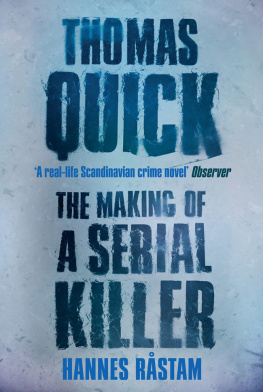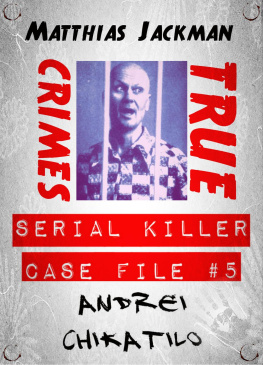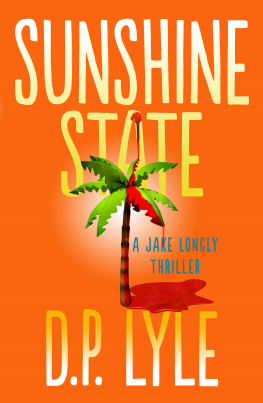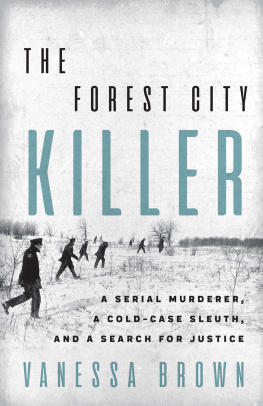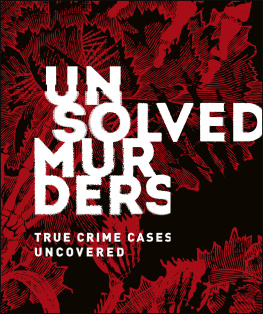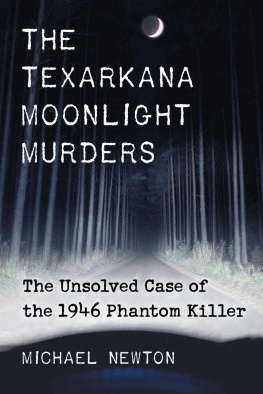Hannes Rstam was an investigative reporter for SVT (Swedish Television). He won a number of awards for his work, including the Guldspaden (the Golden Spade), the Stora Journalistpriset (the Great Journalism Award), the Prix Italia, the Golden Nymph and FIPA dOr. After a battle with cancer, Rstam passed away while finishing this, his first book.
THOMAS QUICK
THE MAKING OF A SERIAL KILLER
HANNES RSTAM
TRANSLATED BY HENNING KOCH
Foreword by Elizabeth Day

CANONGATE
Edinburgh London
Published in Great Britain in 2013 by Canongate Books Ltd,
14 High Street, Edinburgh EH1 1TE
www.canongate.tv
This digital edition first published in 2013 by Canongate Books
Copyright Hannes Rstam, 2012
English translation copyright Henning Koch, 2013
Foreword Elizabeth Day, 2013
The moral right of the author and translator have been asserted
Published by agreement with the Salomonsson Agency
Originally published in 2012 in Swedish as Fallet Thomas Quick by Ordfront
Extract from Doctor Glas by Hjalmar Soderberg. Published by Harvill Press. Reprinted by permission of The Random House Group Ltd.
British Library Cataloguing-in-Publication Data
A catalogue record for this book is available on request from the British Library
ISBN 978 1 78211 070 5
ePub ISBN 978 1 78211 071 2
Editors: Leyla Belle Drake and Mattias Gransson
Fact checkers: Jenny Kttim and Thomas Olsson
Typeset in Adobe Garamond by Palimpsest Book Production Ltd, Falkirk, Stirlingshire
To my children
CONTENTS
FOREWORD BY ELIZABETH DAY
Many of you will find it hard to believe the story you are about to read.
I first came across the extraordinary tale of Thomas Quick, the serial killer who never was, when I read a brief news article in August 2012 about a book that had just been published in Sweden. The book, which went on to be a bestseller, was written by investigative journalist Hannes Rstam and exposed one of the countrys biggest miscarriages of justice in recent times. It told the story of how a patient incarcerated in a psychiatric hospital had confessed to more than thirty murders he never committed.
The man was called Thomas Quick. He was once believed to be Swedens most notorious serial killer. Throughout the 1990s, his bespectacled face stared out from front pages and television screens. The newspapers even gave him his own nickname The Cannibal.
On the strength of his confessions, Quick was convicted of eight murders. But when Rstam started investigating the case in 2008, he discovered that there was not a shred of technical evidence that existed to back up the confessions. There were no DNA traces, no murder weapons and no eyewitnesses nothing apart from Quicks first-hand accounts, many of which were riddled with inaccuracies and had been given when he was under the influence of narcotic-strength drugs.
The book you now hold in your hands is testament to Rstams bloody-minded genius, to the fact that he asked questions and kept asking them, even when it became clear that the Quick scandal reached the highest echelons of Swedish society and even when there were plenty of people who wanted him to stop, who dismissed Rstams painstaking research as wild theorising and who didnt want to admit that something, somewhere had gone so terribly wrong.
Because to admit that Rstam was right was to admit that an innocent man had been wrongfully incarcerated for years. It was to admit that there were murderers at loose who had never been brought to justice for their crimes. That the police, the lawyers and the therapists were all responsible for astonishing lapses of judgement, and an ensuing travesty of justice. And it was to admit that what happened in Sweden could conceivably happen again elsewhere, with equally devastating results.
Perhaps the most extraordinary part of this story is that Rstam was right.
When I read that small news item back in August 2012, it struck me that if I had been watching the tale of Thomas Quick unfold in an episode of a Scandinavian television drama, I would have felt the plot was too far-fetched. But there it was in black and white: this actually happened. I was intrigued. A cursory Internet search showed that Quick, now living under his birth name of Sture Bergwall, was still incarcerated in Ster the same psychiatric hospital where he had made his confessions. He had been acquitted of five of the murders and was awaiting the outcome of two further retrials. I travelled to Sweden to meet him and wrote a piece about the case for the Observer.
I was aware, throughout my trip, that the feature I was writing would not have been possible without the sheer dedication of Hannes Rstam. He was a brilliant investigative journalist. In Sweden, where he started out as a professional bass player before making a career change and becoming a documentary researcher in his late thirties, Rstam had won a clutch of prestigious awards. He was renowned for his fearlessness in tackling big subjects from exposing police cover-ups to tracking down sex-traffickers and for his relentless pursuit of the truth.
At journalism school, his teachers said that if they sent a group of students to cover a car accident, everyone else would have returned to their desks and written the article while Hannes would still be at the scene, examining a wheel nut. The lawyer Thomas Olsson, who worked with Rstam on many of his stories and who now represents Sture Bergwall, says this attention to the tiniest element of an investigation was typical. Hannes was devoted to what he believed was the journalistic mission, and, as a consequence of that, extremely careful with the details, Olsson says. Every statement or detail was turned around several times and had to be confirmed before publishing. I once told him that if the court was as careful about the evidence as he was, there would be no risk whatsoever that anybody would ever be wrongfully convicted of a crime.
He respected the facts. And it was this that led Rstam to the Thomas Quick case. There had long been controversy over the convictions in Sweden but no one had ever been able to nail down exactly why.
Rstam was the first journalist to gain Bergwalls trust. He had a rare capacity to listen and to keep an open mind, and the two men became friends. Hannes was a very intense person with an ability to really listen to other people and also to share, said Bergwall when I met him. It was the first time that I remember thinking, Somethings going to happen. I felt Yes! Somethings going to change, and I was ready to come clean... It was so liberating to finally tell the truth.
In order to establish Bergwalls innocence, Rstam spent years ploughing through thousands of documents, re-interviewing key players and putting together a complex timeline of events on the Quick case. His friend and journalistic colleague, Mattias Gransson, recalled that it took nine seconds for Rstams laptop to calculate the size of his Quick archive. By the end of his investigations, the folder contained 12.5 gigabytes of data and 5,218 documents. To have been able to shape all of that into this coherent and gripping narrative is, in itself, an incredible feat.
Some of what you will read in this book will be discomfiting. A few of the psychiatric transcripts, for instance, are deeply unsettling and border on the bizarre. But this is the language that was used; this is how confused and desperate the whole process had become.
When you read further, you begin to wonder why the close-knit group of people around Quick seemed so eager to believe what he was telling them, and so unwilling to voice dissent from the prevailing view. Rstam would no doubt say it was because they wanted to believe their charge was guilty the more entwined they became in the case, the more their professional reputations were at stake. In stark contrast, Rstam refused to believe anything until it was shown, beyond doubt, to be the truth. He would keep digging until he got there.

